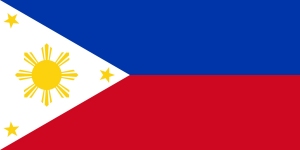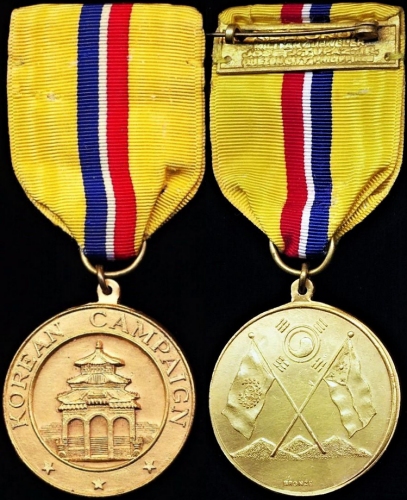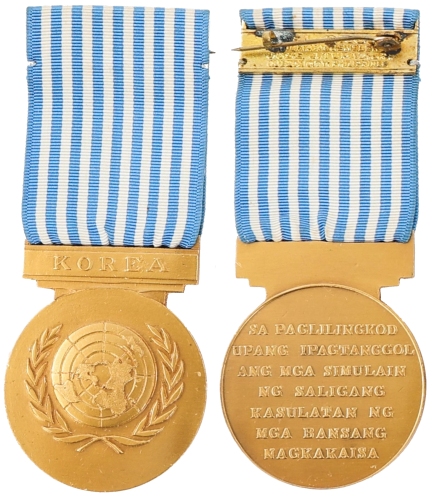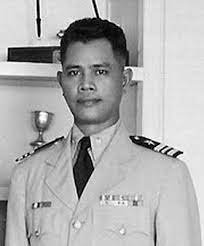
In the Philippines, there is a wide held belief that during World War II, the Koreans were crueler than the Japanese and that they were responsible for the majority of the atrocities committed against the Filipinos.1 Even with these rumors, the Philippines was one of the first countries to recognize the newly independent Republic of Korea in 1949. Filipino assistance and support to South Korea began even before the Korean War, with economic aid in the form of food and agricultural materials. Keep in mind that the devastation caused by the Japanese occupation of the Philippines during World War II had created enormous problems. So much so that the Filipino population decreased steadily for the first 5 years after the war. The situation in the Philippines was dire. It wasn’t until 1950 that production was finally restored to its prewar level.
On June 25, 1950, North Korean forces crossed the 38th Parallel and invaded South Korea. The UN condemned the attack and passed United Nations Security Council Resolution (UNSCR) 82, calling for the cessation of hostilities and withdrawal of North Korean forces. Two days later, UNSCR 83 declared North Korean actions constituted a breach of the peace. On July 31, 1950, UNSCR 84 requested UN members to provide assistance to the United Nations Command in Korea. Days earlier, the U.S. State Department had appointed Douglas MacArthur, as the supreme commander of operations on the Korean Peninsula. To the Filipinos, Douglas MacArthur was a national hero for clearing the Philippines of the Japanese during World War II. The news that MacArthur was participating in the war to protect Korea from communist forces caused some anxiety in the Philippines. Because of MacArthur, many felt that the Philippines should participate in the Korean War. The Philippine congress responded on Sept. 7, 1950 with the approval of the “Philippine Military Aid to the United Nations Act #573”. This made possible the sending of a Filipino military force to South Korea to help repel the communist aggression, and in some small way to repay Douglas MacArthur. Then President Elpidio Quirino (1890-1956) announced that the Philippines was sending the Philippine Expeditionary Force to Korea (PEFTOK) in fulfillment of the country’s obligation as a co-signer of the United Nations Charter.2
The Philippine Army

The obverse has a pagoda within a ring inscribed ‘KOREAN CAMPAIGN’, and three five-pointed stars at the base. The reverse has the crossed flags of the United Nations and the Philippines imposed on stylized mountains in the distance, the Korean Taegukgi above, and the word ‘BRONZE’ at the base. The reverse of the mounting brooch has, in 4 lines, the maker’s name ‘El Oro’ / Military Jeweler / ‘Jose J. Tupaz. Jr’ / Quezon City, Philippines. Until 1984, ‘El-Oro / Jose J. Tupaz. Jr’ was the principal contractor for the Philippine Government for the manufacture of official Filipino, Orders, Decorations, and Medals.
The first of what was to be five Filipino units arrived in Korea in August 1950. It was composed of 1,468 troops, and was the 5th largest force under the United Nations Command. During PEFTOKs deployment, the unit operated alongside the United States 1st Cavalry Division, 3rd Infantry Division, 25th Infantry Division, and 45th Infantry Division.
Over time, the Philippines deployed 5 Battalion Combat Teams (BCT) to Korea. The first unit to arrive was the 10th Battalion Combat Team (Motorized) and served from September 1950 to September 1951. Their motto was: ‘Steady On’. It was to be the Philippines’ only armored battalion, and had a complement of 64 officers and 1,303 enlisted men. The next unit to arrive was the 20th Battalion Combat Team (Leaders) and served from April 1951 to April 1952. Their motto was; ‘We Lead’. Next came the 19th Battalion Combat Team (Bloodhound) which served from April 1952 to March 1953. They were a battle-hardened unit that had distinguished itself in the anti-Huk campaigns in the Philippines. The 19th BCT was the first PEFTOK battalion awarded with the South Korean Presidential Distinguished Unit Citation. It also received a Battle Citation from the US X Corps. They were followed by the 14th Battalion Combat Team (Avengers) who served from March 1953 to April 1954. Their motto was: ‘Crush ‘Em!’. They were named the Avengers by then Secretary of National Defense Ramon Magsaysay (later President of the Philippines) because of their splendid record in the anti-Huk campaigns. For its efforts, the 14th BCT received the South Korean Presidential Unit Citation in December 1953 and the Philippine Presidential Unit Citation upon its return home in March 1954. The final battalion to serve in Korea was the 2nd Battalion Combat Team (Black Lions) which served from April 1954 to May 1955. The 2nd BCT was activated in July 1946, making it one of the most experienced combat units. It gained vast tactical experience with eight years of combat against the Huks in Central and Southern Luzon. In all, the Philippines contributed 7,420 service members to the war effort. They suffered 112 killed in action, 299 wounded, 41 who were POWs and 16 who are classified as Missing in Action.3 All of the recovered bodies were returned to the Philippines for burial.
The PEFTOK Veterans Association, Inc. remains active in promoting awareness about the Philippine participation in the Korean War. Former Philippine President Fidel V. Ramos and two former ambassadors to South Korea: Col. Nicanor Jimenez and Gen. Ernesto Gidaya, were Korean War veterans.
Two Filipino soldiers received the South Korean Order of Military Merit, Taegeuk Medal, their highest military decoration. The recipients were retired Major Maximo Purisima Young (1923-2022) and the late Capt. Conrado D. Yap, both members of the famed 10th BCT. Major Young received the award during the anniversary ceremonies for the Korean War on July 27, 2016. Korea also awarded 8 Ulchi Medals, 4 Chungmu Medals with Gold Star, 13 Chungmu Medals with Silver Star, and 6 Chungmu Medals (without Star). Three Republic of Korea Presidential Unit Citations were awarded. They went to: the 20th BCT on Jun. 11, 1952, the 19th BCT in July 1952, and the 14th BCT on Dec. 6, 1953. There are two Korean War Memorials dedicated to the Philippines. One was built in 1974 and is located in Goyang-si, Kyunggi-do. The other one was erected in 1966 and celebrates the Battle of Yuldong. It is located in Yeoncheon, Kyunggi-do.
The Philippine Presidential Unit citation was awarded twice, one on June 11, 1952, for the Yuldong Battle and one to the 14th BCT for the “Whole Service Period” in March 1954. The Philippines also awarded 1 Medal of Valor, 6 Distinguished Conduct Stars, 1 Distinguished Service Star, 14 Gold Cross Medals, 10 Bronze Cross Medals, and 159 Military Merit Medals. The Philippine Medal of Valor is equivalent to the American Medal of Honor. There have been 41 Medal of Valor recipients since 1935. There are three Korean War Memorials in the Philippines, one at the Philippine Military Academy at Baguio, Benguet, one at Taiguiq (PEFTOK Korean War Memorial) and another one is outside the Philippine-Korea Friendship Center in Metro Manila.
The United States awarded 2 Distinguished Service Crosses (both posthumous), 2 Legions of Merit, 8 Silver Stars, 5 Bronze Stars for Valor, 58 Bronze Stars, and 5 Air Medals. The 19th BCT (“Bloodhounds”) received a U.S. X Corps Battle Citation. For the Chinese Spring Offensive, PEFTOK was awarded a U.S. Presidential Unit Citation.

The reverse inscription is in Tagalog.
At the Battle of Yuldong, April 22–23, 1951, the 10th BCT was given the authority to withdraw because their force of 900 men was severely outnumbered by the Chinese 12th Army of 40,000 men. Outnumbered, and surrounded, the cooks, clerks, drivers and any other available Filipino took up arms and fought as a reserve force component. Capt. Conrado Dumlao Yap had a problem, one of his platoons was being annihilated, and he couldn’t leave his men behind. Instead, he counter-attacked, recovered the dead and rescued his wounded men. Unfortunately, he lost his life in the process. He was awarded the Medal of Valor by the Philippines, the Distinguished Service Cross by the United States and the Order of Military Merit, Taeguk Medal by South Korea, making him the only Filipino decorated by three countries with their most prestigious medals for Valor. The 10th BCT’s refusal to retreat blunted the Chinese offensive. During the battle, the Filipinos suffered 15 killed in action, dozens of wounded, and 14 missing in action. Their perseverance prevented what could have been a total defeat to the UNC. The 10th BCT received an 8th U.S. Army Gallantry Award for their actions.
The Philippine Navy
The Republic of Korea Navy was established as the Marine Defense Group on November 11, 1945. After Korea was liberated, Sohn Won-yil organized the Marine Defense Group in Seoul. The Group formed the Korean Coast Guard and Coast Guard Academy at Chinhae. The Korean Coast Guard acquired 36 patrol boats (mainly ex-Imperial Japanese Navy and U.S. Navy mine sweepers) through the United States Army Military Government in Korea. After the South Korean government was established on August 15, 1948, the Korean Coast Guard became the Republic of Korea Navy, and Sohn was appointed as the first Chief of Naval Operations of the ROK Navy. In October 1949, the ROK Navy purchased a 600-ton submarine chaser, the former USS PC-823, with funds raised among its personnel. She was renamed ROKS Paektusan (Paektu Mountain PC 701), and became the first significant warship of the newly independent nation.
Also, in the early formative days of the Korean Naval Defense Corps, Filipino naval officers played a pivotal role as they brought in the first ships of the Korean Coast Guard to Korea from Subic Bay Naval Base in the Philippines. In August 1947, then LTSG Ramon A. Alcaraz, PN (PMA ’40) was designated as head of the mission to ferry former U.S. and British Royal Navy minesweepers that would form the initial backbone of the Korean Naval Fleet.
The Philippine Navy (PN) actively participated in the Korean conflict. Five Landing Ship Tanks (LSTs) of the Service Squadron of the Philippine Navy, namely RPS Cotabato (T-36), RPS Pampanga (T-37), RPS Bulacan (T-38), RPS Albay (T-39), and RPS Misamis Oriental (T-40) would serve as the workhorse in transporting Filipino soldiers to and from Korea for five years. Two Filipino naval officers served as the Philippine Liaison Group-United Nations Command in Tokyo, Japan. The Philippine LSTs and submarine chasers were not directly engaged in combat action; however, they served an invaluable role in their combat service support and escort operations.
A small footnote

Lieutenant Commander Emilio S. Liwanag (1911 – 1967, Philippine Military Academy graduate 1938) was the only Philippine naval officer to volunteer to serve in the army’s combat contingent. He was assigned to the 10th BCT as an artillery and logistics officer. The 10th BCT had some immediate setbacks upon their arrival in Korea. They had no winter clothing and no heavy armor available for them. (The cold weather of winter was a shock to almost all in the Filipino combat unit, since the Philippines is a tropical island nation.) The 10th was the Philippines’ only armored tank battalion at the time. The Americans were to supply the 10th with 17 M4 Sherman tanks and one M10 tank destroyer, which were supposed to be waiting for them on their arrival in Korea. Unfortunately, during the Battle of the Pusan Perimeter, the promised tanks had been destroyed. For several days after their landing, they received no word from the Americans as to when or if they would receive their armor. The battalion commanders and staff were wondering what to do with two tankless companies once the battalion was assigned a mission, since most of the armor personnel were lightly armed. As the battalion Logistic officer, LCDR Liwanag took it upon himself to rectify the dilemma. Gained during World War II, he had a working knowledge of how the U.S. Army’s logistic supply system functions, and he knew how to bypass the bureaucratic red-tape. To the surprise of everyone in the battalion, he was able to secure seven M24 Chaffee light tanks and several truckloads of brand-new heavy weapons (machine guns, bazookas and 81 mm mortars) and with enough ammunition and grenades for the entire battalion. Just days before his deployment to Korea in 1950, LCDR Liwanag graduated from the Advanced Infantry Gunnery Course at Fort William McKinley. During the Battle of Yuldong, he commanded a battery of 105 mm howitzers. At the end of the 10th BCT deployment, several veterans decided to extend their combat tour instead of returning home. LCDR Liwanag was then assigned as the senior naval advisor to the Philippine Diplomatic Representative for the Philippine Embassy, along with the additional duty of being the Philippine Liaison Officer to the United Nations Command Headquarters in Tokyo, Japan. On July 5, 1951, he was promoted to the rank of Commander. On October 7, 1952, CDR Liwanag was decorated with the Legion of Merit by Maj. Gen. Blackshear M. Bryan for exceptionally meritorious conduct in the performance of outstanding services for the Philippine Liaison office with the UN Command. His Legion of Merit was donated by his family and is currently displayed at the Philippine Military Academy Museum in Baguio, Benguet, Philippines. The Korean War Memorial is within walking distance. Captain Liwanag retired from active duty on Dec. 11, 1963.
Footnotes:
- Lydia N. Yu Jose in her published research article “The Koreans in Second World War Philippines: Rumour and history” states “In the POW and civilian internment camps where crimes were committed, the highest-ranking military officer responsible was an ethnic Korean. It is only in these camps and only under the specific principle of command responsibility that facts support the rumor that the Koreans were ‘more cruel’ than the Japanese. She goes on to say: The documentary sources cited above clearly show that there were very few Koreans in the Philippines during the Second World War – just over 600. Moreover, only 13 Koreans were tried by the Americans in Manila and only two were actually convicted. The documentary sources do not support the rumour.”
- The Philippine Expeditionary Force to Korea (PEFTOK), Spanish: Fuerza Expedicionaria Filipina a Corea (FEFC), Tagalog: Puwersang Expedisyonarya ng Pilipinas sa Korea (PEPK), Korean: 필리핀 한국 원정군.
- The numbers vary depending on the source: Filipino, Korean, United Nations Command.
